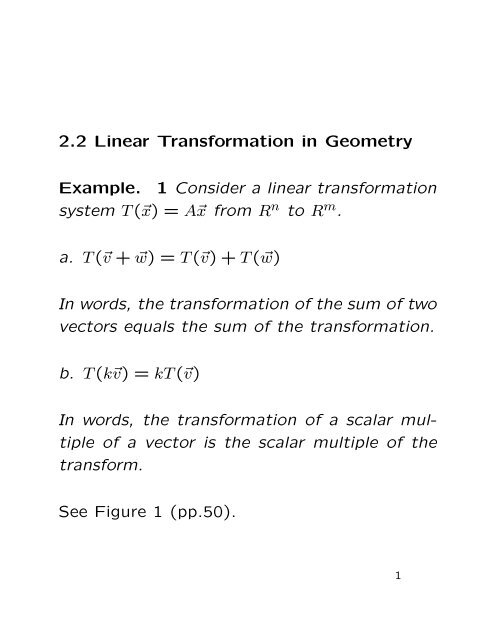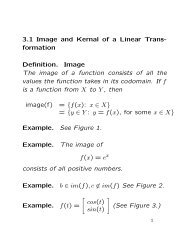2.2 Linear Transformation in Geometry Example. 1 Consider a linear ...
2.2 Linear Transformation in Geometry Example. 1 Consider a linear ...
2.2 Linear Transformation in Geometry Example. 1 Consider a linear ...
You also want an ePaper? Increase the reach of your titles
YUMPU automatically turns print PDFs into web optimized ePapers that Google loves.
<strong>2.2</strong> <strong>L<strong>in</strong>ear</strong> <strong>Transformation</strong> <strong>in</strong> <strong>Geometry</strong><br />
<strong>Example</strong>. 1 <strong>Consider</strong> a l<strong>in</strong>ear transformation<br />
system T (x) = Ax from R n to R m .<br />
a. T (v + w) = T (v) + T ( w)<br />
In words, the transformation of the sum of two<br />
vectors equals the sum of the transformation.<br />
b. T (kv) = kT (v)<br />
In words, the transformation of a scalar multiple<br />
of a vector is the scalar multiple of the<br />
transform.<br />
See Figure 1 (pp.50).<br />
1
Fact A transformation T from R n to R m is<br />
l<strong>in</strong>ear iff<br />
a. T (v + w) = T (v) + T ( w), for all v, w <strong>in</strong> R n ,<br />
and<br />
b. T (kv) = kT (v), for all v <strong>in</strong> R n and all scalars<br />
k.<br />
Proof<br />
Idea: To prove the <strong>in</strong>verse, we must show a<br />
matrix A such that T (x) = Ax. <strong>Consider</strong> a<br />
transformation T from R n to R m that satisfy<br />
(a) and (b), f<strong>in</strong>d A.<br />
2
<strong>Example</strong>. 2 <strong>Consider</strong> a l<strong>in</strong>ear transformation<br />
T from R 2 to R 2 . The vectors Te1 and Te2<br />
are sketched <strong>in</strong> Figure 2. Sketch the image of<br />
the unit square under this transformation.<br />
See Figure 2. (pp. 51)<br />
<strong>Example</strong>. 3 <strong>Consider</strong> a l<strong>in</strong>ear transformation<br />
T from R 2 to R 2 such that T (v1) = 1 2 v1 and<br />
T (v2) = 2v2, for the vectors v1 and v2 <strong>in</strong> Figure<br />
5. On the same axes, sketch T (x), for the<br />
given vector x.<br />
See Figure 5. (pp. 52)<br />
[Rotation]<br />
<strong>Example</strong>. 4 Let T be the counterclockwise<br />
rotation through an angle α.<br />
a. Draw sketches to illustrate that T is a l<strong>in</strong>ear<br />
transformation.<br />
b. F<strong>in</strong>d the matrix of T .<br />
3
<strong>Example</strong>. 5 Give a geometric <strong>in</strong>terpretation<br />
of the l<strong>in</strong>ear transformation.<br />
T (x) =<br />
<br />
a −b<br />
b a<br />
Rotation-dilations A matrix with this form<br />
<br />
a −b<br />
b a<br />
denotes a counterclockwise rotation through<br />
the angle α followed by a dilation by the factor<br />
r where tan(α) = b <br />
a and r = a2 + b2 . Geometrically,<br />
✻<br />
✡ α<br />
✡<br />
✡<br />
✡ ✡✡✡✡✣<br />
✲<br />
a<br />
b<br />
<br />
<br />
=<br />
<br />
x<br />
r cos α<br />
r s<strong>in</strong> α<br />
✲<br />
<br />
4
[Shears]<br />
<strong>Example</strong>. 6 <strong>Consider</strong> the l<strong>in</strong>ear transformation<br />
T (x) =<br />
<br />
1 1 2<br />
0 1<br />
To understand this transformation, sketch the<br />
image of the unit square.<br />
<br />
x<br />
<br />
1 1 2<br />
Solution The transformation T (x) =<br />
0 1<br />
is called a shear parallel to the x1-axis.<br />
5<br />
<br />
x
Def<strong>in</strong>ition. Shear Let L be a l<strong>in</strong>e <strong>in</strong> R 2 . A<br />
l<strong>in</strong>ear transformation T from R 2 to R 2 is called<br />
a shear parallel to L if<br />
a. T (v) = v, for all vectors v on L, and<br />
b. T (v)−v is parallel to L for all vectors x ∈ R 2 .<br />
<strong>Example</strong>. 7 <strong>Consider</strong> two perpendicular vectors<br />
u and w <strong>in</strong> R 2 . Show that the transformation<br />
T (x) = x + (u · ¯x) w<br />
is a shear parallel to the l<strong>in</strong>e L spanned by w.<br />
6
<strong>Consider</strong> a l<strong>in</strong>e L <strong>in</strong> R 2 . For any vector v <strong>in</strong><br />
R 2 , there is a unique vector w on L such that<br />
v − w is perpendicular to L.<br />
v<br />
✒ ❇▼<br />
❇<br />
❇<br />
❇<br />
❇<br />
w<br />
v − w<br />
L<br />
✏✏✏✏✏✏✏✏✏✏✏✏✏✏✏✏✏✏✏✏ <br />
✏✏✏✏✏✏✏✏✏✏✏✏✶❇ How can we generalize the idea of an<br />
orthogonal projection to l<strong>in</strong>es <strong>in</strong> R n ?<br />
<br />
u<br />
v<br />
✒<br />
❇▼<br />
❇<br />
❇<br />
❇<br />
❇<br />
v − w<br />
w = ku<br />
✏✏✏✏✏✏✏✏✏✏✏✏✏✏✏✏✏✏✏✏ <br />
✏✏✏✶ ✏✏✏✏✏✏✏✏✏✏✏✏✶❇ L<br />
7
Def<strong>in</strong>ition. orthogonal projection Let L be<br />
a l<strong>in</strong>e <strong>in</strong> R n consist<strong>in</strong>g of all scalar multiples<br />
of some unit vector u. For any vector v <strong>in</strong> R n<br />
there is a unique vector w on L such that v − w<br />
is perpendicular to L, namely, w = (u·v)u. This<br />
vector w is called the orthogonal projection<br />
of v onto L:<br />
proj L(v) = (u · v)u<br />
The transformation proj L from R n to R n is l<strong>in</strong>ear.<br />
8
Def<strong>in</strong>ition. Let L be a l<strong>in</strong>e <strong>in</strong> R n , the vector<br />
2(proj Lv) − v is called the reflection of v <strong>in</strong> L:<br />
ref L(v) = 2(proj Lv) − v = 2(u · v)u − v<br />
where u is a unit vector on L.<br />
✏✏✏✏✏✏✏✏✏✏✏✏✏✏✏✏✏✏✏✏✏✏✏✏✏✏✏✏✏✏L ✏✏✏✶ ✏✏✏✏✏✏✏✏✏✏✶ projLv<br />
✏✏✏✏✏✏✏✏✏✏✏✏✏✏✏✏✏✏✏✏✶ ❇▼<br />
❇<br />
❇<br />
2projLv<br />
❇<br />
❇<br />
❇<br />
❇<br />
★ ❇<br />
★★★★★★★★❲<br />
v<br />
★ ★★★★★★★★❲<br />
✲<br />
✲<br />
u<br />
refLv<br />
Homework. Exercise <strong>2.2</strong>: 1, 9, 13, 17, 27<br />
9



